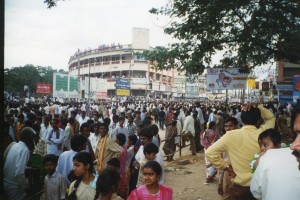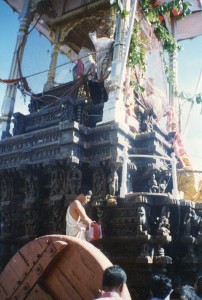Hindu festivals project an abundance of life forms that matches temples’. The ceremonies that take place around temples and throughout towns and villages often express the sense that the universe is a profusion of energies and forms, rather than the static and tame categories that many Westerners favor.
I was in Chennai during Devali. On a spiritual level, this ritual celebrates Rama’s return to his kingdom after a fourteen-year exile. Many people light candles. On a subtle level, this represents our inner light–our ability to apprehend cosmic unity. On a material level, it helps Rama find his way back home. But Devali has levels of meaning that are more colorful.
Or better put, LOUD! For three days, firecrackers burst around the city from morning to night. The explosions were constant.
Someone lit a bottle rocket that fell over as it was launching. We all high-tailed it as it streaked through the crowd.
After the festival a man complained in a local paper called The Hindu about commercial directions that Devali has taken. People used to focus on its spiritual meanings. Now they only care about getting presents and eating food.
Maybe he was just an old man ranting about the young losing respect for traditions. I’ve known many Indians who still deeply honor the festival.
All this liveliness–the parades, explosions, colors, food, candles, incense, banging drums, jostling crowds, devotional songs and political rants in the tropical heat can be interpreted on a strictly sensual level, or as an abundant emanation of the spiritual unity we all share.
You can take your pick. The huge number of forms that celebrations and temples take can encourage many perspectives. And this multiplicity adds all the more to India’s profusion of forms. And to the sense that all things are essentially unified in an abundant flow of energies.



Comments on this entry are closed.